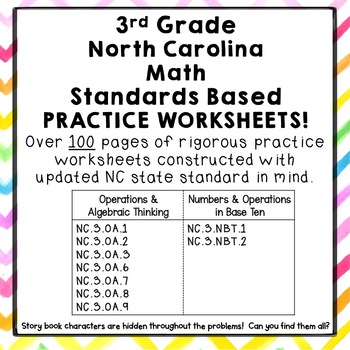3rd Grade North Carolina Standards Based Math Practice
Maggie Bell Teaching
319 Followers
Grade Levels
3rd
Subjects
Resource Type
Standards
CCSS3.NBT.A.1
CCSS3.NBT.A.2
CCSS3.NBT.A.3
CCSS3.OA.A.1
CCSS3.OA.A.2
Formats Included
- PDF
Maggie Bell Teaching
319 Followers
What educators are saying
This was the perfect resource for end of year test prep. We used it in a variety of ways. This product took a HUGE load off my plate. THANK YOU!!!
Description
Say goodbye to scouring the internet and teaching stores for practice worksheets that specifically align to the updated NC math standards.
Use these worksheets for exit tickets, small groups, extra practice and/or homework. These worksheets can be used for independent practice, guided practice or assessment.
There are over 100 worksheets the each include:
- Common Core State Standards
- Clearly stated I can statements
- Important Vocabulary Defintions
- Examples
- Rigorous, focused questions
Total Pages
Answer Key
Included
Teaching Duration
N/A
Report this resource to TPT
Reported resources will be reviewed by our team. Report this resource to let us know if this resource violates TPT’s content guidelines.
Standards
to see state-specific standards (only available in the US).
CCSS3.NBT.A.1
Use place value understanding to round whole numbers to the nearest 10 or 100.
CCSS3.NBT.A.2
Fluently add and subtract within 1000 using strategies and algorithms based on place value, properties of operations, and/or the relationship between addition and subtraction.
CCSS3.NBT.A.3
Multiply one-digit whole numbers by multiples of 10 in the range 10–90 (e.g., 9 × 80, 5 × 60) using strategies based on place value and properties of operations.
CCSS3.OA.A.1
Interpret products of whole numbers, e.g., interpret 5 × 7 as the total number of objects in 5 groups of 7 objects each. For example, describe a context in which a total number of objects can be expressed as 5 × 7.
CCSS3.OA.A.2
Interpret whole-number quotients of whole numbers, e.g., interpret 56 ÷ 8 as the number of objects in each share when 56 objects are partitioned equally into 8 shares, or as a number of shares when 56 objects are partitioned into equal shares of 8 objects each. For example, describe a context in which a number of shares or a number of groups can be expressed as 56 ÷ 8.



